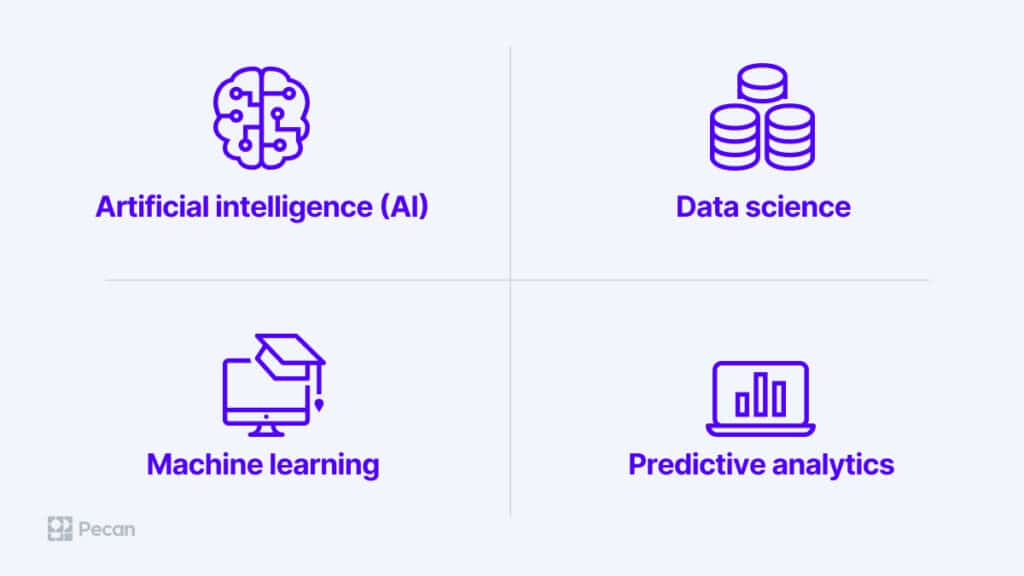In a nutshell:
- Advanced predictive analytics uses data and AI to predict future events and transform industries.
- It provides valuable insights for businesses to make informed decisions and take proactive measures.
- Predictive analytics can be applied to various areas, such as customer behavior analysis, marketing campaign management, and resource planning.
- Using historical data, organizations can anticipate future events and improve overall performance.
- Predictive analytics offers a competitive advantage, helps predict success with customers, and allows businesses to navigate changing market conditions with confidence.
Using predictive analytics in business is a hot topic, but it still feels a little mysterious. People worldwide are intrigued by the potential of data and artificial intelligence to predict future events, grow companies, and transform industries. Check out the Google Trends chart below, showing how search interest in the term “data science” has skyrocketed since 2004:
Google Trends results for "data science," 2004 to present
But a lot of curious searchers probably stop there. The excitement undoubtedly fades when they encounter complicated, jargon-filled explanations of how AI is applied to big data to solve real business challenges.
We know well that the data science field is complex. That’s why Pecan focuses on making data science and predictive modeling accessible to everyone, not just data scientists. In fact, we want every organization to be well-positioned to benefit from the important data innovations reshaping today’s business world. And indeed, 87.8% of executives reported that their companies had increased investments in data, analytics, and AI during 2022, according to a survey reported in the Harvard Business Review.
The value of predictive analytics for any business
Predictive analytics can provide businesses with invaluable insights into future trends and behaviors, allowing them to make informed decisions and take proactive measures.
What is predictive analytics? Based initially on artificial intelligence, it’s an analytical process that leverages data, statistical techniques, and machine learning algorithms to identify the likelihood of future outcomes based on historical data. "Advanced analytics" or "advanced predictive analytics" are other variations on the term.
Whichever term you prefer, predictive analytics combines predictive modeling, machine learning, and process automation to forecast future trends and make recommendations. It goes beyond traditional business intelligence and data analytics methods by using sophisticated techniques and tools to discover deeper insights, make predictions, and generate recommendations. The market for predictive analytics is expected to grow significantly in the coming years — reaching $41B by 2028, according to
There is a ladder of analytics capabilities, starting with descriptive analytics and diagnostic analytics, which provide insights into what happened and why. Predictive and prescriptive analytics are more advanced and focus on the future, using historical and real-time data to identify patterns, trends, and potential outcomes. (Check out our 3-minute explanation of predictive analytics and its relationship to these other types.)
Predictive analytics can be applied to various business processes, such as marketing metrics, supply chain optimization, risk management, and business operations. However it's applied, it enables organizations to gain a competitive advantage by making data-driven decisions and improving overall performance.
Overall, advanced predictive analytics empowers organizations to leverage their data assets, anticipate future events, and optimize their operations for success. With the ability to anticipate and respond to future events, organizations can stay ahead of the competition, reduce costs, and improve overall performance.
Putting predictions to work
Predictive analytics is a rapidly growing field with fantastic potential to transform businesses. Predictive analytics models can accurately predict future events and outcomes by using historical data to identify patterns and relationships. These predictions give organizations a deeper understanding of their customers, market trends, and internal processes.
A wide range of predictive analytical models use data collected by organizations, including even large data sets, to provide insights into future outcomes.
For example, in marketing, predictive analytics can identify which customers are most likely to respond to a particular offer or campaign, allowing businesses to target their efforts more effectively. Campaign management and optimization can also be enhanced by predicting lifetime value and attracting more ideal customers a company seeks.
In demand planning, predictive analytics can be used to identify customer demand trends and plan to ensure customers’ needs are satisfied.
With the ability to forecast future events and behaviors, organizations can make data-driven decisions that improve their efficiency and competitiveness.
In short, learning more about predictive analytics can give business professionals the tools they need to make informed decisions, stay ahead of the curve, and achieve their goals.
That sounds like a pretty great capability, right?
Options and Steps for Implementing Advanced Predictive Analytics
Companies have several options when it comes to implementing advanced and predictive analytics. One option is to use use-case-specific solutions, which provide easy access to complex statistical and mathematical analysis methods. These solutions are designed to address specific business needs and may offer pre-built models and algorithms tailored to particular industries or use cases. For example, Pecan offers a number of solutions that apply predictive analytics for marketing and customer experience teams.
Additional implementation options include:
- Open-source tools like Hadoop and Spark are popular among data scientists due to their low cost, robust functionality, and active user community.
- Proprietary tools from vendors like Microsoft, IBM, and SAS are also potential tools for some teams, though they usually require a more sophisticated technical background.
- Companies can extend their business intelligence (BI) tools with advanced predictive analytics functions to leverage their existing infrastructure and data sources.
- Companies can develop their own proprietary solutions using tools like R and Python libraries that provide extensive functionality for advanced predictive analytics — but also require skilled data scientists or statisticians with coding skills.
Which option is right for your team? You'll have to evaluate your goals and resources, especially the level of technical expertise available.
You'll also need to think about time: When do you need to see results from your predictive analytics effort? Hand-coded models data scientists create can take far longer to develop, test, and move into production for actual business impact. They will also usually mean you have to rely on manual data cleansing and preparation prior to building predictive models, which can take up half or more of data scientists' time (as Anaconda found in a recent survey). Automated predictive analytics solutions can provide much quicker time-to-market in most cases.
Examples of companies' success with advanced predictive analytics
CCG Club Group and AI Demand Forecasting
With a membership base of 2.5 million, CAA Club Group (CCG) has discovered a valuable partner in Pecan's predictive analytics and AI-driven demand forecasting for their roadside assistance services.
Using Pecan's AI forecasting capabilities, CCG now optimizes the scheduling of their rescue vehicles with pinpoint accuracy, relying on highly detailed predictions of member call volume. Before implementing Pecan, the manual forecasting process took a week for each set of forecasts. Pecan has since streamlined this process significantly. CCG was searching for a scalable, automated solution capable of handling extensive data volumes and continuously improving forecasting models.
Pecan has met and exceeded requirements by offering expanded modeling capabilities, facilitating experimentation, and enabling the creation of intricate forecasts specific to locations, timeframes, and service types. This innovative approach has empowered CCG to enhance service quality, reduce response times, and boost member satisfaction throughout the entire service region, all while increasing the efficiency of their in-house data science team. (Check out all the ways advanced predictive analytics in insurance can make a meaningful business impact.)
A Major U.S. Company Sees Savings with Marketing Mix Modeling
Another Pecan customer achieved substantial savings with our MMM (Marketing Mix Modeling). Confronted with an economic downturn despite possessing a billion-dollar marketing budget, a prominent U.S. corporation sought a strategy to optimize marketing expenditures across more than 20 channels. Their objective was to enhance operating margins without compromising revenue.
They turned to Pecan's Marketing Mix Modeling (MMM) to accomplish this goal. This sophisticated solution enabled them to anticipate customer inquiries based on their advertising spending. Leveraging four years of historical data, the model produced precise predictions at both national and state levels. The inclusion of MMM's simulation and optimization features allowed their marketing team to rapidly experiment with various budget allocations and objectives, resulting in remarkable opportunities for cost reduction exceeding $100 million annually across different marketing channels.
Moreover, with the model's ongoing refinement, considering factors like customer lifetime value and cost per acquisition, it promises even more substantial future impacts. This positions machine learning-enhanced MMM as a valuable tool for data-driven planning and maximizing business outcomes.
A guide to the essentials of advanced predictive analytics
Now that you've gotten the essential info about advanced predictive analytics and seen how it can benefit your business, it's time to dive in! Check out our guide, “The What and Why of Predictive Analytics.” The guide explains the basics:
- How predictive analytics works
- Approaches to implementing predictive analytics models
- The benefits of predictive analytics when foreseeing future outcomes is incorporated into your day-to-day decisions
The guide also puts predictive analytics into context with the other frequently used terms you’ve probably encountered, like machine learning and artificial intelligence:
Get our guide to learn about the differences among these commonly used terms: artificial intelligence (AI), data science, machine learning, and predictive analytics
Start exploring predictive analytics and its potential to grow your business with this clear, straightforward guide to the basics.
Check out the excerpt from the guide below that shares three important reasons to consider adopting predictive analytics for your business.
Why Your Business Needs Predictive Analytics Today
New predictive analytics tools make the transformative potential of this technology available to everyone. There’s never been a better time to take your business to the next level by making the most of your data. Unquestionably, it’s an investment that will benefit your team, no matter what area of the business you’re in.Get started today and let your data drive results in weeks1. Own the Competitive Advantage
Keep in mind that your competition is likely already using their data for these purposes, or they will be very soon. Indeed, the wider availability of user-friendly predictive analytics software is making this competitive advantage much more accessible. You want to be the leader in adapting your business decision making to a data-driven approach, making proactive decisions based on accurate predictions about the future, not just “best guesses” based on what happened in the past.2. Predict Success with Customers
Predictive analytics can help you stand out in the sea of companies seeking customers’ attention today. With more choices than ever before, plus rapidly shifting consumer expectations and loyalty, you want every advantage possible. Use predictive analytics to improve the customer experience and maintain the relevance, reputation, and efficiency of your business.3. Build Resilience
It’s obvious that we live in a time of great change and uncertainty. To be sure, pandemics, conflicts, and technological shifts make it difficult to know how to proceed in your business. But if you can use historical data to generate predictions, you can design an informed path forward. Navigate changing market conditions with confidence.Knowing about the future lets you plan for future events, even when things seem unclear. Embracing predictive analytics offers you and your business this special capability — and it’s truly the next step in your business’s evolution.
Ready to get the complete guide? Download it now and accelerate your learning — then accelerate meaningful business outcomes with predictive analytics.
And if you have questions, don’t hesitate to contact Pecan for help! We’re here to support your journey toward predictive analytics success.
Pecan is here to help you find the right advanced predictive analytics solutions for your business, without data scientists. Don’t hesitate to reach out if you’d like to assess your predictive readiness with a quick, easy use case consultation. We’ll help you find the best way to get future-ready.







